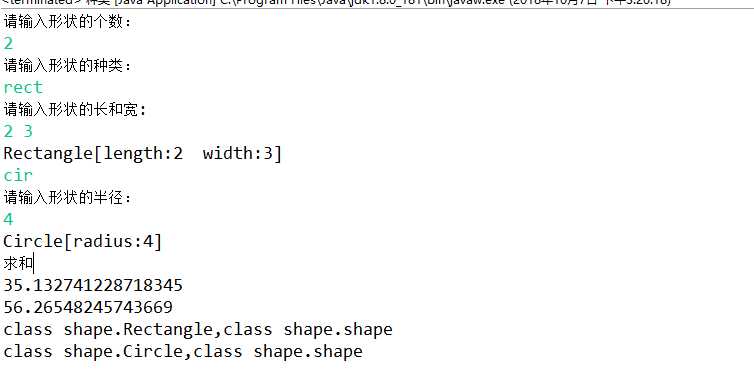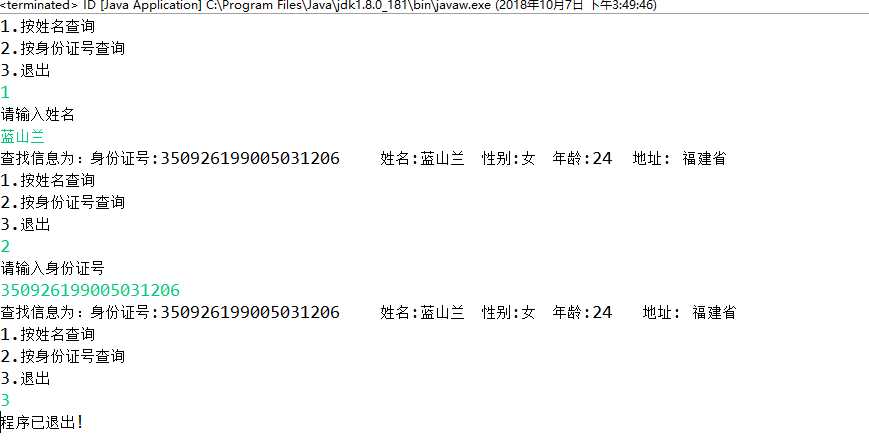标签:ali 继承 产生 use alice 学生 extend -- 构建
第一部分:理论知识学习部分
第五章
第五章学习内容主要分为七个模块,分别为:
1.类、超类和子类;
a. 类继承的格式: class 新类名extends已有类名。
b. 已有类称为:超类(superclass)、基类(base class) 或父类(parent class)
新类称作:子类(subclass)、派生类(derived class)或孩子类(child class)
c.super是一个指示编译器调用超类方法的特有关键字,它不是一个对象的引用,不能将super赋给另一个对象变量
d.从一个超类扩展而来的类集合称为继承层次。在继承层次中,某个类到其祖先的路径被称为该类的继承链。
注:Java不支持多继承。
e.多态性:多态性泛指在程序中同一个符号在不同的情况 下具有不同解释的现象。
f. 不允许继承的类称为final类,在类的定义中用final修饰符加以说明
g.抽象类:抽象方法充当着占位的角色,它们的具体实现在子类中。
抽象类不能被实例化,即不能创建对象,只能产生子类。
2.Object:所有类的超类;
a. Object类是Java中所有类的祖先——每一个类都由它扩展而来。在不给出超类的情况下,Java会自动把Object 作为要定义类的超类。
b.可以使用类型为Object的变量指向任意类型的对象。但要对它们进行专门的操作都要进行类型转换。
c. Object类中的equals方法用于测试某个对象是否同另一个对象相等。它在Object类中的实现是判断两个对象是否具有相同的引用。如果两个对象具有相同的引用,它们一定是相等的。
d. Object类中的hashCode方法导出某个对象的散列码。散列码是任意整数,表示对象的存储地址。
两个相等对象的散列码相等。
3.泛型数组列表;
a. Java中,利用ArrayList类,可允许程序在运行时确定数组的大小。.
b.ArryList是一个采用类型参数的泛型类。为指定数组列表保存元素的对象类型,需要用一对尖括号将数组元素对象类名括起来加在后面。
ArryList<Employee> staff=new ArrayList<Employee>();
4.对象包装器和自动打包;
a. 所有基本数据类型都有着与之对应的预定义类,它们被称为对象包装器。
b. 对象包装器类是不可变的,即一旦构造了包装器,就不允更改包装在其中的值。且对象包装器类还是final,因此不能定义它们的子类。
c. 在JavaSE5.0中,可以自动的将基本数据类型转换为包装器类的对象,将这种变换称为自动打包
5.参数数量可变的方法;
a. 在Java SE 5.0以前的版本中,每个Java方法都有固定数量的参数。然而,现在的版本提供了可以用可变的参数数量调用的方法(称为“可变参 ”方法)。
b. 用户自己可以定义可变参数的方法,并将参数指定为任意类型,甚至是基本类型。
6.枚举类;
a. 声明枚举类
publicenumGrade{A,B,C,D,E};
它包括一个关键字enum,一个新枚举类型的名字 Grade以及为Grade定义的一组值,这里的值既非整型,亦非字符型。
b. 枚举类是一个类,它的隐含超类是java.lang.Enum。
c.枚举值并不是整数或其它类型,是被声明的枚举类的自身实例
7.继承设计的技巧。
a. 将公共操作和域放在超类。
b.不要使用受保护的域。
c.使用继承实现“is-a”关系。
d.除非所有继承的方法都有意义,否则就不要使用继承。
e.在覆盖方法时,不要改变预期的行为。
f.使用多态,而非类型信息。
g.过多地使用反射。
1、实验目的与要求
(1) 理解继承的定义;
(2) 掌握子类的定义要求
(3) 掌握多态性的概念及用法;
(4) 掌握抽象类的定义及用途;
(5) 掌握类中4个成员访问权限修饰符的用途;
(6) 掌握抽象类的定义方法及用途;
(7)掌握Object类的用途及常用API;
(8) 掌握ArrayList类的定义方法及用法;
(9) 掌握枚举类定义方法及用途。
二,实验部分
2、实验内容和步骤
实验1: 导入第5章示例程序,测试并进行代码注释。
测试程序1:
? 在elipse IDE中编辑、调试、运行程序5-1 (教材152页-153页) ;
? 掌握子类的定义及用法;
? 结合程序运行结果,理解并总结OO风格程序构造特点,理解Employee和Manager类的关系子类的用途,并在代码中添加注释。
package inheritance;
/**
* This program demonstrates inheritance.
* @version 1.21 2004-02-21
* @author Cay Horstmann
*/
public class ManagerTest
{
public static void main(String[] args)
{
// construct a Manager object
//构建管理者对象
Manager boss = new Manager("Carl Cracker", 80000, 1987, 12, 15);
boss.setBonus(5000);
Employee[] staff = new Employee[3];//定义一个包含三个雇员的数组
// fill the staff array with Manager and Employee objects
//用Manager和Employee对象填充人员数组
staff[0] = boss;
staff[1] = new Employee("Harry Hacker", 50000, 1989, 10, 1);
staff[2] = new Employee("Tommy Tester", 40000, 1990, 3, 15);
// print out information about all Employee objects
//打印所有员工对象的信息
for (Employee e : staff)
System.out.println("name=" + e.getName() + ",salary=" + e.getSalary());
//输出每个人的薪水
}
}
package inheritance;
import java.time.*;
public class Employee
{
private String name;
private double salary;
private LocalDate hireDay;
public Employee(String name, double salary, int year, int month, int day)
{
this.name = name;
this.salary = salary;
hireDay = LocalDate.of(year, month, day);
}
public String getName()
{
return name;
}
package abstractClasses;
import java.time.*;
public class Employee extends Person
{
private double salary;
private LocalDate hireDay;
public Employee(String name, double salary, int year, int month, int day)
{
super(name);
this.salary = salary;
hireDay = LocalDate.of(year, month, day);
}
public double getSalary()
{
return salary;
}
public LocalDate getHireDay()
{
return hireDay;
}
public String getDescription()
{
return String.format("an employee with a salary of $%.2f", salary);
}
public void raiseSalary(double byPercent)
{
double raise = salary * byPercent / 100;
salary += raise;
}
}

测试程序2:
? 编辑、编译、调试运行教材PersonTest程序(教材163页-165页);
? 掌握超类的定义及其使用要求;
? 掌握利用超类扩展子类的要求;
? 在程序中相关代码处添加新知识的注释。
PersonTest:
package abstractClasses;
/**
* This program demonstrates abstract classes.
* @version 1.01 2004-02-21
* @author Cay Horstmann
*/
public class PersonTest
{
public static void main(String[] args)
{
Person[] people = new Person[2];
// fill the people array with Student and Employee objects
//用学生和员工对象填充人员数组
people[0] = new Employee("Harry Hacker", 50000, 1989, 10, 1);
people[1] = new Student("Maria Morris", "computer science");
// print out names and descriptions of all Person objects
//打印出所有person对象的名称和描述
for (Person p : people)
System.out.println(p.getName() + ", " + p.getDescription());
}
}
Person:
package abstractClasses;
public abstract class Person//定义抽象类型Person
{
public abstract String getDescription();//定义抽象描述
private String name;
public Person(String name)
{
this.name = name;
}
public String getName()
{
return name;
}
}
Employee:
package abstractClasses;
import java.time.*;
public class Employee extends Person//子类Employee继承父类Person
{
private double salary;
private LocalDate hireDay;
public Employee(String name, double salary, int year, int month, int day)
{
super(name);//继承父类的方法
this.salary = salary;
hireDay = LocalDate.of(year, month, day);//hireDay使用LocalDate的方法
}
public double getSalary()
{
return salary;
}
public LocalDate getHireDay()
{
return hireDay;
}
public String getDescription()
{
return String.format("an employee with a salary of $%.2f", salary);
}
public void raiseSalary(double byPercent)
{
double raise = salary * byPercent / 100;
salary += raise;
}
}
Student:
package abstractClasses;
public class Student extends Person//子类Student继承父类Person
{
private String major;
/**
* @param nama the student‘s name
* @param major the student‘s major
*/
public Student(String name, String major)
{
// 将name传递给父类构造函数
super(name);
this.major = major;
}
public String getDescription()
{
return "a student majoring in " + major;
}
}
测试结果如下所示

测试程序3:
? 编辑、编译、调试运行教材程序5-8、5-9、5-10,结合程序运行结果理解程序(教材174页-177页);
? 掌握Object类的定义及用法;
? 在程序中相关代码处添加新知识的注释。
EqualsTest:
package equals;
/**
* This program demonstrates the equals method.
* @version 1.12 2012-01-26
* @author Cay Horstmann
*/
public class EqualsTest
{
public static void main(String[] args)
{
Employee alice1 = new Employee("Alice Adams", 75000, 1987, 12, 15);
Employee alice2 = alice1;
Employee alice3 = new Employee("Alice Adams", 75000, 1987, 12, 15);
Employee bob = new Employee("Bob Brandson", 50000, 1989, 10, 1);
System.out.println("alice1 == alice2: " + (alice1 == alice2));
System.out.println("alice1 == alice3: " + (alice1 == alice3));
System.out.println("alice1.equals(alice3): " + alice1.equals(alice3));
System.out.println("alice1.equals(bob): " + alice1.equals(bob));
System.out.println("bob.toString(): " + bob);
Manager carl = new Manager("Carl Cracker", 80000, 1987, 12, 15);
Manager boss = new Manager("Carl Cracker", 80000, 1987, 12, 15);
boss.setBonus(5000);
System.out.println("boss.toString(): " + boss);
System.out.println("carl.equals(boss): " + carl.equals(boss));
System.out.println("alice1.hashCode(): " + alice1.hashCode());
System.out.println("alice3.hashCode(): " + alice3.hashCode());
System.out.println("bob.hashCode(): " + bob.hashCode());
System.out.println("carl.hashCode(): " + carl.hashCode());
}
}
Employee:
package equals;
import java.time.*;
import java.util.Objects;
public class Employee
{
private String name;
private double salary;
private LocalDate hireDay;
public Employee(String name, double salary, int year, int month, int day)
{
this.name = name;
this.salary = salary;
hireDay = LocalDate.of(year, month, day);
}
public String getName()
{
return name;
}
public double getSalary()
{
return salary;
}
public LocalDate getHireDay()
{
return hireDay;
}
public void raiseSalary(double byPercent)
{
double raise = salary * byPercent / 100;
salary += raise;
}
public boolean equals(Object otherObject)
{
// 快速测试,看看这些对象是否相同
if (this == otherObject) return true;
// 如果显式参数为空,则必须返回false
if (otherObject == null) return false;
// 如果类不匹配,它们就不能相等
if (getClass() != otherObject.getClass()) return false;
// 现在我们知道otherObject是一个非空雇员
Employee other = (Employee) otherObject;
// 测试字段是否具有相同的值
return Objects.equals(name, other.name) && salary == other.salary && Objects.equals(hireDay, other.hireDay);
}
public int hashCode()
{
return Objects.hash(name, salary, hireDay);
}
public String toString()
{
return getClass().getName() + "[name=" + name + ",salary=" + salary + ",hireDay=" + hireDay
+ "]";
}
}
Manager:
package equals;
public class Manager extends Employee//子类Manager继承父类Employee
{
private double bonus;
public Manager(String name, double salary, int year, int month, int day)
{
super(name, salary, year, month, day);
bonus = 0;
}
public double getSalary()
{
double baseSalary = super.getSalary();
return baseSalary + bonus;
}
public void setBonus(double bonus)
{
this.bonus = bonus;
}
public boolean equals(Object otherObject)
{
if (!super.equals(otherObject)) return false;
Manager other = (Manager) otherObject;
// super.equals检查这个和其他属于同一个类
return bonus == other.bonus;
}
public int hashCode()
{
return java.util.Objects.hash(super.hashCode(), bonus);
}
public String toString()
{
return super.toString() + "[bonus=" + bonus + "]";
}
}

测试程序4:
? 在elipse IDE中调试运行程序5-11(教材182页),结合程序运行结果理解程序;
? 掌握ArrayList类的定义及用法;
? 在程序中相关代码处添加新知识的注释。
ArrayListTest:
package arrayList;
import java.util.*;
/**
* This program demonstrates the ArrayList class.
* @version 1.11 2012-01-26
* @author Cay Horstmann
*/
public class ArrayListTest
{
public static void main(String[] args)
{
// 用三个Employee对象填充staff数组列表
ArrayList<Employee> staff = new ArrayList<>();
staff.add(new Employee("Carl Cracker", 75000, 1987, 12, 15));
staff.add(new Employee("Harry Hacker", 50000, 1989, 10, 1));
staff.add(new Employee("Tony Tester", 40000, 1990, 3, 15));
// 把每个人的薪水提高5%
for (Employee e : staff)
e.raiseSalary(5);
// 打印所有Employee对象的信息
for (Employee e : staff)
System.out.println("name=" + e.getName() + ",salary=" + e.getSalary() + ",hireDay="
+ e.getHireDay());
}
}
Employee:
package arrayList;
import java.time.*;
public class Employee
{
private String name;
private double salary;
private LocalDate hireDay;
public Employee(String name, double salary, int year, int month, int day)
{
this.name = name;
this.salary = salary;
hireDay = LocalDate.of(year, month, day);
}
public String getName()
{
return name;
}
public double getSalary()
{
return salary;
}
public LocalDate getHireDay()
{
return hireDay;
}
public void raiseSalary(double byPercent)
{
double raise = salary * byPercent / 100;
salary += raise;
}
}
测试结果如下所示:

测试程序5:
? 编辑、编译、调试运行程序5-12(教材189页),结合运行结果理解程序;
? 掌握枚举类的定义及用法;
? 在程序中相关代码处添加新知识的注释。
package enums;
import java.util.*;
/**
* This program demonstrates enumerated types.
* @version 1.0 2004-05-24
* @author Cay Horstmann
*/
public class EnumTest
{
public static void main(String[] args)
{
Scanner in = new Scanner(System.in);
System.out.print("Enter a size: (SMALL, MEDIUM, LARGE, EXTRA_LARGE) ");
String input = in.next().toUpperCase();
Size size = Enum.valueOf(Size.class, input);
System.out.println("size=" + size);
System.out.println("abbreviation=" + size.getAbbreviation());
if (size == Size.EXTRA_LARGE)//判断语句
System.out.println("Good job--you paid attention to the _.");
}
}
enum Size
{
SMALL("S"), MEDIUM("M"), LARGE("L"), EXTRA_LARGE("XL");
private Size(String abbreviation) { this.abbreviation = abbreviation; }
public String getAbbreviation() { return abbreviation; }
private String abbreviation;
}
测试结果如下所示:

实验2:编程练习1
? 定义抽象类Shape:
属性:不可变常量double PI,值为3.14;
方法:public double getPerimeter();public double getArea())。
? 让Rectangle与Circle继承自Shape类。
? 编写double sumAllArea方法输出形状数组中的面积和和double sumAllPerimeter方法输出形状数组中的周长和。
? main方法中
1)输入整型值n,然后建立n个不同的形状。如果输入rect,则再输入长和宽。如果输入cir,则再输入半径。 2) 然后输出所有的形状的周长之和,面积之和。并将所有的形状信息以样例的格式输出。 3) 最后输出每个形状的类型与父类型,使用类似shape.getClass()(获得类型),shape.getClass().getSuperclass()(获得父类型);
思考sumAllArea和sumAllPerimeter方法放在哪个类中更合适?
输入样例:
3
rect
1 1
rect
1 1
rect
2 2
cir
1
rect
2 2
cir
1
输出样例:
18.28
8.14
[Rectangle [width=1, length=1], Rectangle [width=2, length=2], Circle [radius=1]]
class Rectangle,class Shape
class Rectangle,class Shape
class Circle,class Shape
package shape;
import java.util.Scanner;
public class Test {
public static void main(String[] args) {
Scanner in = new Scanner(System.in);
System.out.println("个数");
int a = in.nextInt();
System.out.println("种类");
String rect="rect";
String cir="cir";
Shape[] num=new Shape[a];
for(int i=0;i<a;i++){
String input=in.next();
if(input.equals(rect)) {
System.out.println("长和宽");
int length = in.nextInt();
int width = in.nextInt();
num[i]=new Rectangle(width,length);
System.out.println("Rectangle["+"length:"+length+" width:"+width+"]");
}
if(input.equals(cir)) {
System.out.println("半径");
int radius = in.nextInt();
num[i]=new Circle(radius);
System.out.println("Circle["+"radius:"+radius+"]");
}
}
Test c=new Test();
System.out.println("求和");
System.out.println(c.sumAllPerimeter(num));
System.out.println(c.sumAllArea(num));
for(Shape s:num) {
System.out.println(s.getClass()+","+s.getClass().getSuperclass());
}
}
public double sumAllArea(Shape score[])
{
double sum=0;
for(int i=0;i<score.length;i++)
sum+= score[i].getArea();
return sum;
}
public double sumAllPerimeter(Shape score[])
{
double sum=0;
for(int i=0;i<score.length;i++)
sum+= score[i].getPerimeter();
return sum;
}
}
package shape;
abstract class Shape { //定义抽象父类Shape
abstract double getPerimeter(); //定义求解周长的方法
abstract double getArea(); //定义求解面积的方法
}
class Rectangle extends Shape{
private int length;
private int width;
public Rectangle(int length, int width) {
this.length = length;
this.width = width;
}
//继承父类
double getPerimeter(){ //调用父类求周长的方法
return 2*(length+width);
}
double getArea(){
return length*width; //调用父类求面积的方法
}
}
class Circle extends Shape{
private int radius;
public Circle(int radius) {
this.radius = radius;
}
double getPerimeter(){
return 2 * Math.PI * radius;
}
double getArea(){
return Math.PI * radius * radius;
}
}
测试结果如下所示

实验3: 编程练习2
编制一个程序,将身份证号.txt 中的信息读入到内存中,输入一个身份证号或姓名,查询显示查询
package id1;
import java.io.BufferedReader;
import java.io.File;
import java.io.FileInputStream;
import java.io.FileNotFoundException;
import java.io.IOException;
import java.io.InputStreamReader;
import java.util.ArrayList;
import java.util.Scanner;
public class Main{
private static ArrayList<Student> studentlist;
public static void main(String[] args) {
studentlist = new ArrayList<>();
Scanner scanner = new Scanner(System.in);
File file = new File("C:\\Users\\ASUS\\Desktop\\新建文件夹\\身份证号.txt");
try {
FileInputStream fis = new FileInputStream(file);
BufferedReader in = new BufferedReader(new InputStreamReader(fis));
String temp = null;
while ((temp = in.readLine()) != null) {
Scanner linescanner = new Scanner(temp);
linescanner.useDelimiter(" ");
String name = linescanner.next();
String number = linescanner.next();
String sex = linescanner.next();
String year = linescanner.next();
String province =linescanner.nextLine();
Student student = new Student();
student.setName(name);
student.setnumber(number);
student.setsex(sex);
student.setyear(year);
student.setprovince(province);
studentlist.add(student);
}
} catch (FileNotFoundException e) {
System.out.println("学生信息文件找不到");
e.printStackTrace();
} catch (IOException e) {
System.out.println("学生信息文件读取错误");
e.printStackTrace();
}
boolean isTrue = true;
while (isTrue) {
System.out.println("1.按姓名查询");
System.out.println("2.按身份证号查询");
System.out.println("3.退出");
int nextInt = scanner.nextInt();
switch (nextInt) {
case 1:
System.out.println("请输入姓名");
String studentname = scanner.next();
int nameint = findStudentByname(studentname);
if (nameint != -1) {
System.out.println("查找信息为:身份证号:"
+ studentlist.get(nameint).getnumber() + " 姓名:"
+ studentlist.get(nameint).getName() +" 性别:"
+studentlist.get(nameint).getsex() +" 年龄:"
+studentlist.get(nameint).getyaer()+" 地址:"
+studentlist.get(nameint).getprovince()
);
} else {
System.out.println("不存在该学生");
}
break;
case 2:
System.out.println("请输入身份证号");
String studentid = scanner.next();
int idint = findStudentByid(studentid);
if (idint != -1) {
System.out.println("查找信息为:身份证号:"
+ studentlist.get(idint ).getnumber() + " 姓名:"
+ studentlist.get(idint ).getName() +" 性别:"
+studentlist.get(idint ).getsex() +" 年龄:"
+studentlist.get(idint ).getyaer()+" 地址:"
+studentlist.get(idint ).getprovince()
);
} else {
System.out.println("不存在该学生");
}
break;
case 3:
isTrue = false;
System.out.println("程序已退出!");
break;
default:
System.out.println("输入有误");
}
}
}
public static int findStudentByname(String name) {
int flag = -1;
int a[];
for (int i = 0; i < studentlist.size(); i++) {
if (studentlist.get(i).getName().equals(name)) {
flag= i;
}
}
return flag;
}
public static int findStudentByid(String id) {
int flag = -1;
for (int i = 0; i < studentlist.size(); i++) {
if (studentlist.get(i).getnumber().equals(id)) {
flag = i;
}
}
return flag;
}
}
package id1;
public class Student {
private String name;
private String number ;
private String sex ;
private String year;
private String province;
public String getName() {
return name;
}
public void setName(String name) {
this.name = name;
}
public String getnumber() {
return number;
}
public void setnumber(String number) {
this.number = number;
}
public String getsex() {
return sex ;
}
public void setsex(String sex ) {
this.sex =sex ;
}
public String getyaer() {
return year;
}
public void setyear(String year ) {
this.year=year ;
}
public String getprovince() {
return province;
}
public void setprovince(String province) {
this.province=province ;
}
}
测试结果如下所示

三 实验总结
在理论课上老师为我们的理论基础进行了加深和稳固再加上我一周自主学习,大概掌握了一些关于继承的相关知识,但其实到现在,我自己的基础还是相对薄弱,理论知识和实验能力都相对欠缺。所以这几次作业还大多停留在通过借鉴其他同学的水平上。不过我也希望通过自己的学习早日脱离这种情况。也希望通过接下来的学习我的理论部分和实验能力都能有所提升。
201771010124 王海珍 《实验六 继承定义与使用》第六章实验总结
标签:ali 继承 产生 use alice 学生 extend -- 构建
原文地址:https://www.cnblogs.com/www-whz-1997/p/9725227.html